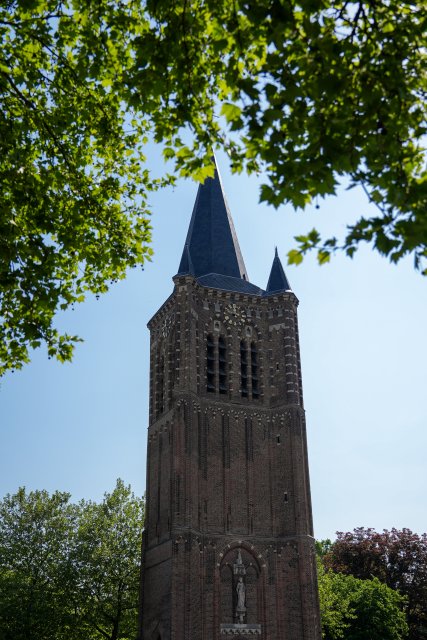Tower of the former Roman Catholic church of St. Peter's Banden
National Monument
In 959 A.D., Heraclius was appointed the next bishop of Liege by Bruno - brother of Archbishop Otto of Cologne. Bruno gave Heraclius the rights over several domains to provide tax revenue for the diocese of Liege, on the condition that he would establish Petrus churches here. After all, Bruno had a fondness for St. Peter. He had one of the "original" bands of St. Peter brought over to Cologne from Rome. He had existing churches in his area of jurisdiction dedicated to St. Peter and he also founded new ones. Presumably Son too thus received a church as early as the 10th century.
Shortly after 1400, the - now stone - Son church was expanded with a small choir. A new replacement high church would be attached to that small choir 50 years later. To finance this, the administration of Son received permission from Duke Philip the Good in 1445 to sell 12 bunder (+/- 12 hectares) of common land. Buyer of that land was Adam Marcelis die Luwe. The highly constructed replacement of the small low Son church was built between 1446 and 1459. The richly decorated tower (including with marlstone) was not completed until around 1526, equipped with a needle spire that fell during a heavy storm in 1800. Not until 1887 was a new, somewhat lower spire erected by order of pastor Dobbelsteen, still considerably higher than the current spire since 1975.
Architect Pierre Cuypers did good business with design commissions for neo-gothic churches in places such as Veghel (1855), Eindhoven (1858) and Ospel (1865). From 1887, Geldrop, Lierop and Uden would also receive a large new church, recognizable by the large dome between nave and choir, designed by architect Carl Weber.
In this explosion of religious expression in the second half of the 19th century, the envious Son priest Dobbelsteen wanted to get rid of what he saw as the outdated and somber appearance of the church in Son. From 1860 on, the interior of the church was completely stripped. The ancient low choir (dating from about 1400) was raised, pillars were milled out decoratively and the roof beam construction was protected with cross vaults of wood, plaster, straw and lime. The entire church was painted in white, gray, green and red, furnished with a large number of wooden statues of saints, a large, high richly decorated main altar, a beautiful pulpit made of carved wood, an altar of Mary and an altar of Cornelius. Not exactly fireproof, but pleasing to the eye and still accommodating 250 believers - for the population of the time, that was still sufficient.
After the devastating fierce fire on December 29, 1958 and the demolition of the nave and choir in 1966, only the tower remained, which was restored in 1974-1975.The tower has since housed a carillon of 50 bells, played twice a week by a carillonneur. Automatic playing sounds every fifteen minutes.
Behind the tower, the pavement shows the outline of the church.
